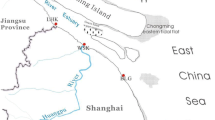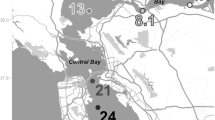Abstract
In this study, temporal variability of nosZ genotypes was evaluated in two intertidal rocky biofilms and two intertidal sediment sites of the Douro River estuary, Portugal. The results were compared to rates of key N-cycle processes and environmental variables to examine possible links between denitrifier community dynamics and N biogeochemistry. Genetic heterogeneity of the nosZ gene was evaluated by terminal restriction fragment length polymorphism analysis (T-RFLP) and by sequencing cloned nosZ gene fragments. Phylogenetic analysis showed that the majority of the nosZ genes detected were most similar to nosZ genes from isolates affiliated with alpha-subclass of the class Proteobacteria. Results revealed low nosZ genotype richness, and hierarchical cluster analysis showed significant differences in the composition of denitrifier communities that inhabit different intertidal environments of the Douro River estuary. Monthly surveys of nosZ genotypes from sandy sediments showed that, while the same T-RFLP peaks were present in all samples, shifts in the relative peak areas of the different nosZ genotypes occurred. Canonical correspondence analysis, based on data from the monthly survey, revealed a strong relationship between the relative peak areas of some T-RFLP operational taxonomic units (OTUs) with denitrification rate and \( {\text{NO}}^{{\text{ - }}}_{{\text{3}}} \) availability. Results suggest that denitrifiers with specific nosZ genotypes (OTUs) have competitive advantage over others when \( {\text{NO}}^{{\text{ - }}}_{{\text{3}}} \) fluctuates in the system; these fluctuations reflect, in turn, variability in denitrification rates.





Similar content being viewed by others
References
Ahn Y-H (2006) Sustainable nitrogen elimination biotechnologies: a review. Process Biochem 41:1709–1721
Altschul SF, Gish W, Miller W, Myers EW, Lipman DJ (1990) Basic local alignment search tool. J Mol Biol 215:403–410
Avrahami S, Conrad R, Braker G (2002) Effect of soil ammonium concentration on N2O release and on the community structure of ammonia oxidizers and denitrifiers. Appl Environ Microbiol 68:5685–5692
Barton L, McLay CDA, Schipper LA, Smith CT (1999) Annual denitrification rates in agricultural and forest soils: a review. Aust J Soil Res 37:1073–1094
Braker G, Tiedje JM (2003) Nitric oxide reductase (norB) genes from pure cultures and environmental samples. Appl Environ Microbiol 69:3476–3483
Braker G, Zhou J, Wu L, Devol AH, Tiedje JM (2000) Nitrite reductase genes (nirK and nirS) as functional markers to investigate diversity of denitrifying bacteria in Pacific Northwest marine sediment communities. Appl Environ Microbiol 66:2096–2104
Braker G, Ayala-del-Río HL, Devol AH, Fesefeldt A, Tiedje JM (2001) Community structure of denitrifiers, Bacteria, and Archaea along redox gradients in Pacific Northwest marine sediments by terminal restriction fragment length polymorphism analysis of amplified nitrite reductase (nirS) and 16S rRNA genes. Appl Environ Microbiol 67:1893–1901
Castro-González M, Braker G, Farías L, Ulloa O (2005) Communities of nirS type denitrifiers in the water column of the oxygen minimum zone in the eastern South Pacific. Environ Microbiol 7:1298–1306
Cavigelli MA, Robertson GP (2001) Role of denitrifier diversity in rates of nitrous oxide consumption in a terrestrial ecosystem. Soil Biol Biochem 33:297–310
Clarke KR, Warwick RM (1994) Change in Marine Communities: An Approach to Statistical Analysis and Interpretation. Plymouth Marine Laboratory, Plymouth
Cornwell JC, Kemp WM, Kana TM (1999) Denitrification in coastal ecosystems: methods, environmental controls, and ecosystem level controls, a review. Aquat Ecol 33:41–54
Corredor JE, Morell JM, Bauza J (1999) Atmospheric nitrous oxide fluxes from mangrove sediments. Mar Pollut Bull 38:473–478
Devol AH (1991) Direct measurements of nitrogen gas fluxes from continental sediments. Nature 349:319–321
Enwall K, Philippot L, Hallin S (2005) Activity and composition of denitrifying bacterial community respond differently to long-term fertilization. Appl Environ Microbiol 71:8335–8343
Liu X, Tiquia SM, Holguin G, Wu L, Nold SC, Devol AH, Luo K, Palumbo AV, Tiedje JM, Zhou J (2003) Molecular diversity of denitrifying genes in continental margin sediments within the oxygen-deficient zone off Pacific coast of Mexico. Appl Environ Microbiol 69:3549–3560
Lueders T, Friedrich MW (2003) Evaluating of PCR amplification bias by terminal restriction fragment length polymorphism analysis of small-subunit rRNA and mcrA genes by using defined template mixtures of methanogenic pure cultures and soil DNA extracts. Appl Environ Microbiol 69:320–326
Magalhães CM, Bordalo AA, Wiebe WJ (2002) Temporal and spatial patterns of intertidal sediment-water nutrient and oxygen fluxes in the Douro River estuary, Portugal. Mar Ecol Prog Ser 233:55–71
Magalhães CM, Joye SB, Moreira RM, Wiebe WJ, Bordalo AA (2005) Effect of salinity and inorganic nitrogen concentrations on nitrification and denitrification rates in intertidal sediments and rocky biofilms of the Douro River estuary, Portugal. Water Res 39:1783–1794
Magalhães CM, Wiebe WJ, Joye SB, Bordalo AA (2005) Inorganic nitrogen dynamics in intertidal rocky biofilms and sediments of the Douro River estuary (Portugal). Estuaries 28:592–606
Magalhães CM, Bano N, Hollibaugh JT, Wiebe WJ, Bordalo AA (2007) Composition and activity of betaproteobacteria ammonia-oxidizing communities associated with intertidal rocky biofilms and sediments of the Douro River Estuary, Portugal. J Appl Microbiol (in press) DOI 10.1111/j.1365-2672.2007.03390.x
Nogales B, Timmis KN, Nedwell DB, Osborn AM (2002) Detection and diversity of expressed denitrification genes in estuarine sediments after reverse transcription-PCR amplification from mRNA. Appl Environ Microbiol 68:5017–5025
Paul JH, Myers B (1982) Fluorometric determination of DNA in aquatic microorganisms by use of Hoechst 33258. Appl Environ Microbiol 43:1393–1399
Priemé A, Braker G, Tiedje JM (2002) Diversity of nitrite reductase (nirK and nirS) gene fragments in forested upland and wetlend soils. Appl Environ Microbiol 68:1893–1900
Rich JJ, Myrold DD (2004) Community composition and activities of denitrifying bacteria from adjacent agricultural soil, riparian soil, and creek sediment in Oregon, USA. Soil Biol Biochem 36:1431–1441
Rich JJ, Heichen RS, Bottomley PJ, Cromack K Jr, Myrold DD (2003) Community composition and functioning of denitrifying bacteria from adjacent meadow and forest soils. Appl Environ Microbiol 69:5974–5982
Rösch C, Mergel A, Bothe H (2002) Biodiversity of denitrifying and dinitrogen-fixing bacteria in an acid forest soil. Appl Environ Microbiol 68:3818–3829
Scala DJ, Kerkhof LJ (1998) Nitrous oxide reductase (nosZ) gene-specific PCR primers detection of denitrifiers and three nosZ genes from marine sediments. FEMS Microbiol Lett 162:61–68
Scala DJ, Kerkhof LJ (1999) Diversity of nitrous oxide reductase (nosZ) genes in continental shelf sediments. Appl Environ Microbiol 65:1681–1687
Scala DJ, Kerkhof LJ (2000) Horizontal heterogeneity of the denitrifying bacterial communities in marine sediments by terminal restriction fragment length polymorphism analysis. Environ Microbiol 66:1980–1986
Seitzinger SP (1988) Denitrification in freshwater and coastal marine ecosystems: Ecological and geochemical significance. Limnol Oceanogr 33:702–724
Seitzinger SP (2000) Scaling up: site-specific measurements to global-scale estimates of denitrification. In: Hobbie JE (ed) Estuarine Science: A Synthetic Approach to Research and Practice. Island Press, Montague, pp 211–241
Sharma S, Aneja MK, Mayer J, Munch JC, Schloter M (2005) Diversity of transcripts of nitrite reductase genes nirK and nirS in Rhizospheres of grain legumes. Appl Environ Microbiol 71:2001–2007
Song B, Ward BB (2003) Nitrite reductase genes in halobenzoate degrading denitrifying bacteria. FEMS Microbiol Ecol 43:349–357
Stres B, Mahne I, Avguštin G, Tiedje JM (2004) Nitrous oxide reductase (nosZ) gene fragments differ between native and cultivated Michigan soils. Appl Environ Microbiol 70:301–309
ter Braak CJF, Smilaeur P (2002) CANOCO reference manual and CanoDraw for Windows user’s guide: software for Canonical Community Ordination (version 4.5). Microcomputer Power, Ithaca
Throbäck IN, Enwall K, Jarvis, A, Hallin S (2004) Reassessing PCR primers targeting nirS, nirK and nosZ genes for community surveys of denitrifying bacteria with DGGE. FEMS Microbiol Ecol 49:401–417
Vieira MEC, Bordalo AA (2000) The Douro estuary (Portugal): a mesotidal salt wedge. Oceanol Acta 23:585–594
von Wintzingerode F, Göbel UB, Stackebrandt E (1997) Determination of microbial diversity in environmental samples: pitfalls of PCR-based rRNA analysis. FEMS Microbiol Rev 21:213–329
Wolsing M, Priemé A (2004) Observation of high seasonal variation in community structure of denitrifying bacteria in arable soil receiving artificial fertilizer and cattle manure by determining T-RFLP of nir gene fragments. FEMS Microbiol Ecol 48:261–271
Yan T, Fields MW, Wu L, Zu Y, Tiedje JM, Zhou J (2003) Molecular diversity and characterization of nitrite reductase gene fragments (nirK and nirS) from nitrate- and uranium-contaminated groundwater. Environ Microbiol 5:13–24
Yoshie S, Noda N, Tsuneda S, Hirata A, Inamori Y (2004) Salinity decreases nitrite reductase gene diversity in denitrifying bacteria of wastewater treatment systems. Appl Environ Microbiol 70:3152–3157
Zumft WG (1992) The denitrifying prokaryotes. In: Balows A, Trüper HG, Dworkin M, Harder W, Schleifer K-H (eds) The Prokaryotes: A Handbook on the Biology of Bacteria: Ecophysiology, Isolation, Identification, Applications, Vol. 1. Springer-Verlag, New York, pp 554–582
Zumft WG (1997) Cell biology and molecular basis of denitrification. Microbiol Mol Biol Rev 61:533–616
Acknowledgements
We thank M. J. Magalhães, I. Azevedo, S. Ramos, R. Moreira, and L. Torgo for their assistance in fieldwork and during the incubations, and two anonymous reviewers for their extremely helpful comments on the manuscript. This study was funded by the Portuguese Science and Technology Foundation through a Ph.D. fellowship to C.M.M. (SFRH/BD/1397/2000) and a research grant to A.A.B (POCTI/CTA/39034/2001). J.T.H. and N.B.'s contribution to this research was supported by a grant from the US Environmental Protection Agency's Science to Achieve Results Estuarine and Great Lakes Coastal Initiative through funding to the Pacific Estuarine Ecosystem Indicator Research Consortium, US EPA Agreement #EPA/R-82867601.
Author information
Authors and Affiliations
Corresponding author
Additional information
An erratum to this article can be found at http://dx.doi.org/10.1007/s00248-008-9419-2
Rights and permissions
About this article
Cite this article
Magalhães, C., Bano, N., Wiebe, W.J. et al. Dynamics of Nitrous Oxide Reductase Genes (nosZ) in Intertidal Rocky Biofilms and Sediments of the Douro River Estuary (Portugal), and their Relation to N-biogeochemistry. Microb Ecol 55, 259–269 (2008). https://doi.org/10.1007/s00248-007-9273-7
Received:
Accepted:
Published:
Issue Date:
DOI: https://doi.org/10.1007/s00248-007-9273-7




